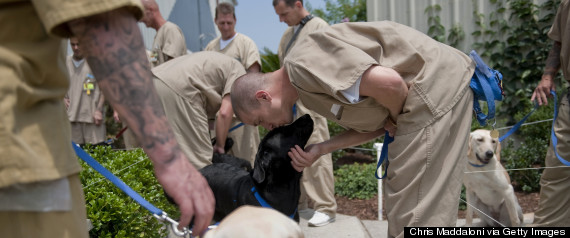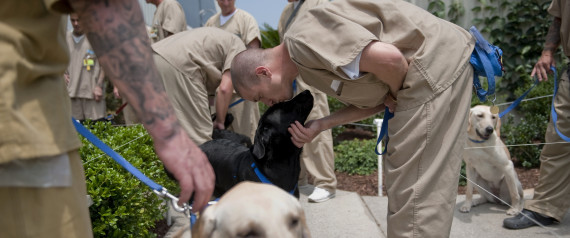11 Amazing Prison Stories From 2013
The Huffington Post
|
By Shadee Ashtari
Posted: 12/31/2013 7:32 am EST | Updated: 12/31/2013 8:44 am EST
Rachel Harris, a rookie detention officer at Lower Buckeye Jail in Maricopa County, Ariz., was conducting a routine cell check in June when inmate Bobby Ruiz allegedly jumped on her back and bit off a piece of her ear, Fox 10 reported.
According to Harris and jail surveillance video, inmates rushed upstairs to aid Harris, peeling Ruiz off the 22-year-old guard. Inmates Ricky Shillingford and Andrew Davis were the first to come to Harris’ aid.
"He had her in a chokehold, I saw the blood was coming from her ears," Shillingford, who broke his hand in the scuffle, told Fox 10.
"I seen her on the floor, crunched over, hunched over. I snatched him off of her, and then he took a swing at me and went back toward her," Davis said.
Harris told Fox 10 that she knew the inmates were there to help her. After the attack, her ear wrapped in gauze, Harris thanked the inmates who rescued her.
"I just want to say thank you to those of you who did help me. I really don't know if I would have came out with anything more if you guys didn't help me, so thank you," Harris said.
"Right is right and wrong is wrong," Davis told Fox 10. "We make mistakes to get in here. But hey, if you can correct your mistakes, why not?"
Washington state inmates rescued three three boys from drowning in Salmon Creek.
"Just 'cause we're incarcerated doesn't mean we're bad people," 28-year-old Jon Fowler, one of the inmates, told KPTV. "We made some bad choices in our lives, but we're still, we're just like everybody else. We're just paying our debt for what we did wrong."
The boys, ages 8, 10 and 16, fell into the 45-degree water after their canoe capsized. As soon as the inmates spotted the boys in the water beside their overturned canoe, the three men dived into the creek and fished out the boys one by one.
“I don’t think I was thinking at all,” 37-year-old Nelson Pettis, another inmate involved in the rescue, told The Columbian.
The third inmate, 29-year-old Larry Bohn, made numerous trips into the water, rescuing the oldest boy before diving back in to help Pettis with the others. Once the boys were on dry ground, both Pettis and Bohn wrapped their shirts around them to keep them warm until the rescue crews arrived.
“He looked real bad,” Bohn told The Columbian referring to the 8-year-old. “They were saying, 'thank you' repeatedly. They just seemed really scared.”
Along with the three brothers, two of the inmates were taken to a nearby hospital for mild hypothermia, according to Chief Jerry Green of Clark County Fire District 6.
"I think we did something that any good person would do," Fowler told KPTV. You see three helpless kids in a river, you help. That's what you do."
Exonerated prisoners started nonprofit detective agency to free other innocent inmates.

After serving almost 13 years of a Texas life sentence, Christopher Scott was exonerated of murder after another suspect in the case confessed to the crime in 2009.
In an April interview with WUNC-FM at the Innocence Network Conference in Charlotte, N.C., Scott reflected on his battle to prove his innocence.
“I think it’s the first time I actually cried, when [my lawyer] told me I had a million-to-one chance to make it," Scott said. "I went back to him the next day and I told him, ‘You gave me a million-to-one chance to make it. I’m gonna be that one out of the million.”
While Scott’s case hinged on mistaken identity, others have been cleared by DNA analysis years after they were convicted.
Scott, now owner of his own men’s apparel store, Christopher’s Men’s Wear, has united with dozens of other exonerated former prisoners in Dallas County to launch the House of Renewed Hope, a nonprofit amateur detective agency that helps free wrongfully convicted inmates.
The House of Renewed Hope also lobbies Texas legislators for greater compensation for ex-inmates who have been exonerated and increased access to public services, including health care.
Tech-savvy Oklahoma inmates developed computer software that may save their state millions.

A handful of tech-savvy inmates at the Joseph Harp Correctional Center in Lexington, Okla., got together to create data-collection software that three state lawmakers said may save Oklahoma millions of dollars a year, according to The Oklahoman.
The program, which has been in place for the past two years, was initially developed to prevent prisoners from receiving multiple meals per dining session. Data collected by the system also showed that the food vendor, Sysco, was charging varying amounts for the same product at different facilities, which quickly became a point of concern for state lawmakers, The Oklahoman reports.
If the software was implemented in correctional facilities statewide, the program could save the state almost $20 million every year, Bobby Cleveland, an Oklahoma state representative and chairman of the state House Public Safety Committee, told The Washington Post in October.
“It’s a pretty neat program," Cleveland told the Post.
"It’s all done by the direction of the supervisor, one of these guys who’s kind of, what do you call it, thinking outside the box.”
Two of the three inmates, whose names were withheld by Oklahoma Corrections Department spokesman Jerry Massie and state lawmakers, are serving time for murder and sexual offenses, according to The Oklahoman.
Washington state prison inmates prepared rescue cats for adoption.
As of February, the inmate adoption program, coordinated with the West Columbia Gorge Humane Society, has hosted five cats, allowing inmates to feed, care for and socialize maladapted felines until they are ready for adoption.
To qualify for the program, inmates must undergo an interview with prison staff, maintain a positive behavioral record with the Department of Corrections and have no violent crimes or animal abuse in their history.
One inmate at Larch Correction Center, Jerry Warfield, spoke to 14 WFIE about Jinx, a skittish cat previously living with hoarders.
"In a situation like this, normally, typically you don't have a lot of responsibility, so when you go back to the community, you're not used to the responsibility, so it kind of overwhelms you," Warfield told 14 WFIE. "This, it kind of keeps you on track, gives you a sense of responsibility. It helps build you and prepare you for your release.
“And of course they love you back and it’s always good to feel love. … They don’t judge ya,” Warfield added.
Paws in Prison program: Prisoners saved shelter dogs from death row.

In an effort to make dogs more adoptable and provide rehabilitation skills to inmates, nationwide programs like Arkansas’ “Paws in Prison” pair incarcerated individuals with dogs that would otherwise be euthanized because of unmanageable or dangerous behavioral issues. The training program tasks qualified prisoners with socializing rescue dogs from shelters and teaching them basic obedience skills in preparation of adoption.
“I’ve been looking for ways to just -- even if it’s small -- to give back to society in some way,” James Dulaney, a Tucker Correctional Facility inmate and Paws for Prison participant in Arkansas, told The Associated Press in June. Dulaney is serving life for murder.
“The dogs have a remarkable impact on offenders, improving offender behavior and giving offenders incentive to maintain excellent conduct records,” George A. Lombardi, director of the Missouri Department of Corrections, told the AP.
All-prisoner fire crews in California helped battle the raging Rim Fire near Yosemite National Park.

Of the nearly 4,000 firefighters dispatched to battle one of the largest wildfires in California history, 673 were male and female state prison inmates.
California's voluntary Conservation Camps program, begun by the state Department of Corrections and Rehabilitation and the Department of Forestry and Fire Protection, allows inmates to serve their communities while providing cooperative agencies with an additional trained workforce for emergencies, including fires, floods and earthquakes.
"They are in the thick of it," Capt. Jorge Santana of the corrections department told NBC. "They work 24-hour shifts. They sleep in tents at base camp. They work side-by-side with other firefighters."
Inmates must undergo intensive two-week physical training in addition to two weeks of fire safety and suppression techniques training.
"A lot of people think you pull that fire engine up and just pull a hose out and fight fire," Cal Fire Capt. Mike Mohler told National Geographic. "We're talking inmates who hike miles and miles just to get where they're going to start, and then cut line all through the day."
Qualified inmates, who are meticulously screened, medically cleared and must have no history of violent crimes, earn $1.45 to $3.90 per day for projects ranging from fire breaks to flood protection, according to the California Conservation Camps website.
“Our inmate firefighters are vital to our fire protection system here in California,” Daniel Berlant, Cal Fire spokesman, told Time magazine.
The California Conservation Program saves state taxpayers an average of $80 million annually and helps inmates return to society when their sentences end.
“A lot of these guys come in and have never held a job, never had any self-worth,” Correctional Lt. L.A. von Savoye, public information officer at the Sierra Conservation Center, told Time. “Within a very short time their mentality changes. They take pride in what they’re doing. They’re giving back to their communities. It gives them purpose.”
There are currently 42 adult and two juvenile Conservation Camps in California, with nearly 4,000 inmate participants.
Inmates grew new lives through prison gardens program.
Unfortunately your browser does not support IFrames.
Prisoners have been growing vegetables, fruits and flowers in prison yards across the country, helping them gain vocational landscaping skills and a peaceful outlet for frustrations.
“We believe that everybody has a heart and everybody has a chance for transformation,” Beth Waitkus, director of the Insight Garden Program at California's San Quentin state prison, told ABC.
A 46-year-old career criminal named Bernard has been an active member of Willard Cybulski Correctional Institution’s gardening efforts in Enfield, Conn., according to ABC News.
“I get a sense of peace and a sense of serenity being that I’m in a hostile environment at times and then coming out here to pick these vegetables. It brings calmness to me,” Bernard, who, like other inmates interviewed by ABC, didn't give his last name.
Dennis, a San Quentin inmate serving 22 years for burglary, told ABC the program has had shocking effects on him, including reduced aggression.
“I’m sitting next to this guy that I would have been fighting on some other yard. It really amazed me that I could actually prune plants and dig in soil,” the budding expert on soil composition told ABC. “It really touched me.”
In Connecticut, all 18 state prisons have garden programs, none of which cost taxpayers a dime. In 2012, the state’s prisons yielded more than 35,000 pounds of produce for prisoners, which saved Connecticut taxpayers $20,000 in prison costs. Surplus food from prison garden programs is donated to charities.
“We give 25 percent of what we pick back to the community and that’s the most fulfilling thing, that I’m helping someone,” Bernard told ABC. “Because in my life, I have taken in trouble. So, to me, it’s almost like paying back a debt to be able to pick something and be able to give back to others.”
“I’ve been in and out since I’ve been 15, and this is the first time I’ve done something like this,” Rasheed, another San Quentin inmate, told ABC. “I can connect spiritually with something as simple as garden. … To me that was different.”
According to Connecticut's 2011 Annual Recidivism Report, recidivism of state convicts after their release from prison approaches 60 percent. But San Quentin garden prisoners see a recidivism rate of less than 10 percent, and none of Connecticut’s garden graduates have returned to jail since their release, Waitkus told ABC.
The Last Mile prison program has been transforming inmates into tech-savvy entrepreneurs.

In 1995, Chrisfino Kenyatta Leal was convicted of possessing a firearm after two previous armed robbery convictions. Under California’s three strikes law, he was given a prison sentence of 25 years to life. Nineteen years later, California Prop 36 allowed him to qualify for resentencing. Leal was released from prison in July, according to Business Insider.
While imprisoned, Leal was one of dozens of inmates enrolled in The Last Mile, an entrepreneurship program that provides qualified inmates with the technological skills they need to get jobs upon release. To qualify, inmates must apply, provide peer recommendations and undergo administrator review. The six-month program, founded by Silicon Valley investors Chris Redlitz and wife Beverly Parenti, includes twice-weekly training sessions on social media, which covers the basics of Twitter, blogging and Quora, a question-and-answer website that has allowed inmates to enter the world of social media through volunteer intermediaries.
"Before The Last Mile, I was going to be an electrician" if paroled, Leal told Business Insider. "But when the program came along, I realized there's a whole world out there I wasn't aware of. When I was incarcerated, the Internet was just starting to take off, so I didn't really get too much of an understanding for it. Once I started taking classes through The Last Mile sessions, all of those questions were answered."
Upon his release in June, Leal became a full-time intern at tech company RocketSpace. After four months, he was hired as a full-time operations associate, Business Insider reports.
Since The Last Mile’s 2011 launch, six program alumni have been released from prison and have secured employment. Currently, 30 inmates are enrolled in The Last Mile, according to Business Insider.
Vermont inmates helped families of fallen war heroes.
"I'm an auto body technician by trade, so I can take that to the table in here and share that particular skill with them," inmate and program mentor Mark King told WCAX.
In May, St. Alban’s Harley Time participants chose to donate two Harley-Davidson motorcycles to Vermont Fallen Families, which supports people who have lost loved ones in battle.
Marion Gray, the Vermont Fallen Families president, lost a son in 2004 to the Iraq war and was deeply moved by the inmates’ tribute, sparking her first trip to a prison to personally thank the inmates.
"I wanted to hear in their own words why they chose us," Gray told WCAX, fighting back tears as she hugged each participant individually. "They're wonderful kids regardless of the circumstances, in my book, for wanting to do this."
The inmates custom-designed the motorcycles with military blue paint and 42 gold stars to symbolize each Vermont service member lost in battle.
"We know that your son, Jamie, is on here along with his fallen brothers and sisters. So God bless them," King told Gray.
Two Virginia Beach prisoners saved a fellow inmate from suicide attempt.
Virginia Beach inmates Antonio Tabron and Kwaku Acheampong were eating breakfast one Sunday morning in March when they noticed fellow inmate Donnie Bullard preparing to hang himself from a bed sheet in his cell, according to WAVY.com.
Tabron and Acheampong called nearby guards for assistance as they talked Bullard out of suicide.
"I remember getting up on the table," Bullard, who had been imprisoned for a month, told WAVY. "I told one of them I was going to hang myself and he said, 'Not here.' Then, I went and got on my bed."
Tabron and Acheampong declined to be interviewed, but Bullard spoke with WAVY to publicly thank the inmates who saved his life.
"I felt relieved that they had come," Bullard told WAVY. "I thank them for what they've done, stopping me. It could have been worse.”
Bullard is incarcerated for simple assault on law enforcement and driving while intoxicated. Acheampong is serving time for simple assault on law enforcement, damaged property and disorderly conduct. Tabron is imprisoned for rape.
Florida prisoners saved a 64-year-old prison guard from being choked to death by violent inmate.
This incident occurred in November 2009, but the exceptional actions of these inmates warrants renewed applause.
Deputy Ken Moon was the lone guard on duty at the Orient Road Jail in Tampa, Fla., when he was violently attacked by inmate Douglas Burden, as revealed by the jail surveillance video.
Burden, jailed for drug dealing and drunk driving, placed the 64-year-old guard in what officials later called a “rear naked choke,” a martial arts strangle that cuts off the blood to the brain.
Within moments, inmate Jerry Dieguez Jr., serving time for armed home invasion, ran to Moon’s defense, punching Burden in the face. More inmates flooded the room to help in Moon’s rescue. As some inmates peeled Burden off the guard, others used Moon's radio to call for help, according to theDaily Mail.
Col. James Previtera, commander of Hillsborough County's Department of Detention Services, told reporters that the inmates "saved the deputy's life," describing the attack as “fast” and “violent.”
“The response of the inmates in this case, I think, speaks volumes as to the fact that we treat these men and women ... in our facilities with a lot of respect," Previtera added.
When reporters asked Previtera why the inmates rushed to Moon’s aid, he relayed the inmates’ response: “He was a good guy and they liked him.”
Burden was placed in solitary confinement with added charges of attacking an officer, according to the Daily Mail.
Moon was treated at a hospital for injuries, but was released the same day.
Also on HuffPost:
